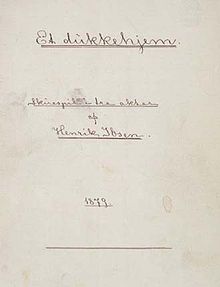| A Doll's House | |
|---|---|
 Original manuscript cover page, 1879 | |
| Written by | Henrik Ibsen |
| Characters |
|
| Date premiered | 21 December 1879 |
| Place premiered | Royal Danish Theatre, Copenhagen, Denmark |
| Original language | Norwegian, Danish |
| Subject | The awakening of a middle-class wife and mother |
| Genre | Naturalistic / realistic problem play Modern tragedy |
| Setting | The home of the Helmer family in an unspecified Norwegian town or city, c. 1879 |
A Doll's House (Danish and Bokmål: Et dukkehjem; also translated as A Doll House) is a three-act play written by Norwegian playwright Henrik Ibsen. It premiered at the Royal Danish Theatre in Copenhagen, Denmark, on 21 December 1879, having been published earlier that month.[1] The play is set in a Norwegian town c. 1879.
The play concerns the fate of a married woman, who, at the time in Norway, lacked reasonable opportunities for self-fulfillment in a male-dominated world. Despite the fact that Ibsen denied it was his intent to write a feminist play, it was a great sensation at the time[2] and caused a "storm of outraged controversy" that went beyond the theater to the world of newspapers and society.[3]
In 2006, the centennial of Ibsen's death, A Doll's House held the distinction of being the world's most-performed play that year.[4] UNESCO has inscribed Ibsen's autographed manuscripts of A Doll's House on the Memory of the World Register in 2001, in recognition of their historical value.[5]
The title of the play is most commonly translated as A Doll's House, though some scholars use A Doll House. John Simon says that A Doll's House is "the British term for what [Americans] call a 'dollhouse'".[6] Egil Törnqvist says of the alternative title: "Rather than being superior to the traditional rendering, it simply sounds more idiomatic to Americans."[7]
- ^ Meyer (1967, 477).
- ^ Krutch, Joseph Wood (1953). "Modernism" in Modern Drama, A Definition and an Estimate. Ithaca: Cornell University Press. p. 9. OCLC 176284.
- ^ Walter, McFarlane, James; Jens, Arup (1998). Four Major Plays. Oxford University Press. ISBN 0192833871. OCLC 39674082.
{{cite book}}: CS1 maint: multiple names: authors list (link) - ^ "Henrik Ibsen's psychodramas still grip the world 100 years after his death". Pravda Report. 22 May 2006. Retrieved 30 May 2017.
- ^ "Henrik Ibsen: A Doll's House". UNESCO. Retrieved 30 May 2017.
- ^ "Baptism by Fire Island". New York. 15 July 1991.
- ^ Törnqvist, Egil (1995). Ibsen: A Doll's House. Capilano University Press. p. 54. ISBN 9780521478663. OCLC 635006762.